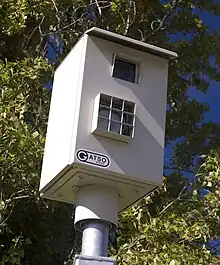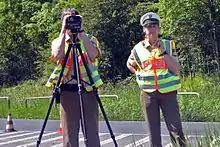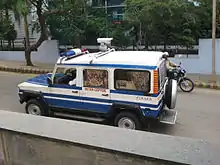車速限制執法
[[Category::en:Speed_limit_enforcement正在翻譯的條目|㏴車速限制執法]]

為提高司機對車速限制的遵守程度,當局在大多數公共道路上強制執行限速。使用的方法包括由警察在路邊測速(如使用雷達槍)和路邊科技執法系統,這些系統可能會結合自動車牌識別系統。傳統上,警察使用秒錶來測量車輛行駛已知距離所需的時間。而近年,雷達槍和車載系統開始被使用。
一項包括全球的研究發現,測速相機令致命及嚴重傷害事故數量減少了11%至44%。英國交通部估計,測速相機使有人受傷的事故減少了22%,而在攝像頭附近意外重傷或死亡的人數減少了42%[1] 。英國醫學期刊最近報導稱,測速相機可以有效減少附近的事故和傷害,並建議更廣泛地安裝。一項2017 年倫敦政治經濟學院的研究提出:「在英國道路上再安裝1,000 個攝像頭每年可以挽救多達190條生命,減少多達1,130起碰撞事故並減少330起重傷。」[2]
歷史
限速的使用早於機動車的發明和執法。面對汽車的發明,許多國家製定了車速限制法律,並採取了合適的方法去執法。[3]英國的《机车法案》設置了針對車輛的速度限制,並於後來規定了執法方法。1861年通過的第一個機車法案將在無人居住的地區的速度限制設為10 英里每小時(16 公里每小時),而在城鎮內則為5 英里每小時(8 公里每小時)以及製定了對違法行為的罰款金額。
1865年的《機車法案》出台了更嚴格的規定,該法案規定城鎮內的速度限制為2 英里每小時(3.2 公里每小時),出城的速度限制為4 英里每小時(6.4 公里每小時)。 該法案更要求在車輛前面 60 碼需有人舉著紅旗以作警告。1878年再修法,將車輛前方警告者的距離減少到 20 碼,並且要求車輛在看到馬匹時停車。[4]由於車速不能超過人的行走速度,車速限制實際上是多餘的。
到1895年,一些早期的輕型蒸汽動力車司機認為這些汽車在法律上歸類為無馬車輛,因此車前不需要有人作警告。 汽車先驅約翰·亨利·奈特 (John Henry Knight) 以此作測試,但他後來因無照使用機車而被檢控[5]。1896年的《公路機車法案》取消了1865年法案引入的一些限制,特別是將 3 噸以下的「輕型機車」的速度限制提高到 14 英里每小時(23 公里每小時)。1903年修法再次將限速提高到 20 英里每小時(32 公里每小時)。
英國一個與汽車有關的調查委員會於1907年發布報告,並對在農村地區測速以提高罰款收入而非保護城鎮居民生命的做法表示擔憂。 在當時的議會辯論中,有人指出「警察不是駐紮在村莊中可能有危險的地方,而是隱藏在開闊道路旁的樹籬或溝渠中」,並且 「作為對公眾的保護的說法顯然是荒謬的,它們在許多地方僅被用作從路過的旅行者中榨取金錢的一種手段,這讓人想起中世紀的強盜」。[6][7]
1905年,英國汽車協會成立以幫助駕車者避開執法。[8] 1910年,首席大法官阿爾弗斯頓勳爵 (Lord Alverston) 對一名汽車協會巡邏員和一名可能超速駕駛的司機提起了一個測試案件(貝茨訴史蒂文斯)中裁定,如果巡邏員向超速駕駛的司機發出減速信號,從而避免測速執法,該人可能犯下1885 年《預防犯罪修正案》中阻差辦公的罪行。[9][10]隨後,該協會開發了一個警告系統並一直使用到1960 年代,除非附近有警察測速,巡邏員會向展示協會徽章的汽車司機敬禮,但前提是他們不會因不敬禮而被起訴。[11]
Gatsometer BV公司由拉力賽車手莫里斯·加特索尼德斯(Maurice Gatsonides)於 1958 年創立,其所生產的“Gatsometer”被喻為「革命性的測速設備」。[12] 它最初是為了提高比賽成績而開發的,但在後來被當作警察執法工具發售。Gatsometer 聲稱它們在1971年開發出了第一台用於道路交通的雷達,但這一說法卻因雷達探測器早在1967年就已經上市銷售而受到質疑。[12]而Gatsometer也在1982年生產出世界上第一台移動測速攝像頭。[12][13]
在1968年2月,北卡羅來納州、紐約州和印第安納州開始使用了VASCAR系統,用作紀錄車輛的平均速度。[14]
凱文·理查森 (Kevin Richardson) 提出了以超速罰款作為資金來源,為遵守速度限制的司機提供現金抽獎作獎勵。而這個想法在2010年11月在瑞典斯德哥爾摩實踐。[15]
實踐方法

Speed limits were originally enforced by manually timing or "clocking" vehicles travelling through "speed traps" defined between two fixed landmarks along a roadway that were a known distance apart; the vehicle's average speed was then determined by dividing the distance travelled by the time taken to travel it. Setting up a speed trap that could provide legally satisfactory evidence was usually time-consuming and error-prone, as it relied on its human operators.
Average speed measurement
VASCAR is a device that semi-automates the timing and average speed calculation of the original manually operated "speed trap". An observer on the ground, in a vehicle or in the air simply presses a button as a vehicle passes two landmarks that are a known distance apart, typically several hundred metres.
Automatic number plate recognition (ANPR) systems that use a form of optical character recognition read the vehicle's licence or registration plate. A computer system reads vehicle registration plates at two or more fixed points along a road, usually hundreds of meters or even kilometers apart, then uses the known distance between them to calculate a vehicle's average speed. From the mean value theorem, we know that the vehicle's speed must equal its average speed at some time between the measurements. If the average speed exceeds the speed limit, then a penalty is automatically issued.[16]
Police in some countries like France have been known to prosecute drivers for speeding, using an average speed calculated from timestamps on toll road tickets.[17]
Speed enforcement using average speed measurement is expressly prohibited in California.[18]
Instantaneous speed measurement
.jpg.webp)
Instantaneous speed cameras measure the speed at a single point. These may either be a semi-permanent fixture or be established on a temporary basis. A variety of technologies can be used:
- Radar speed guns use a microwave signal that is directed at a vehicle; the Doppler effect is used to derive its speed.
- LIDAR speed guns utilize the time of flight of laser pulses to make a series of timestamped measurements of a vehicle's distance from the laser; the data is then used to calculate the vehicle's speed.[19]
- Sensors embedded in the roadway in pairs, for example electromagnetic induction or Piezo-electric strips a set distance apart.[20]
- Infra-red light sensors located perpendicular to the road, e.g. TIRTL.
Pacing
Officers in some jurisdictions may also use pacing, particularly where a more convenient radar speed measuring device is not available—a police vehicle's speed is matched to that of a target vehicle, and the calibrated speedometer of the patrol car used to infer the other vehicle's speed.[21]
Cameras
In recent years many jurisdictions began using cameras to record violators. These devices detect vehicles that are exceeding the speed limit and take photos of these vehicles' license plates. A ticket is then mailed out to the registered owner.
Other
Some jurisdictions such as Australia and Ohio, allow prosecutions based on a subjective speed assessment by a police officer.[22][23] In the future there is the potential to track speed limit compliance via GPS black boxes for recidivist speeders identified in the Australian National Road Safety Strategy 2011 - 2020 section on Intelligent speed adaptation.
參考文獻
- Wilson, C; Willis, Hendrikz. (PDF). The Cochrane Database of Systematic Reviews (10). 2010. PMID 20927736. doi:10.1002/14651858.CD004607.pub3.
- Science, London School of Economics and Political. . London School of Economics and Political Science.
- Willett, T. C. . Abingdon, Oxon https://www.worldcat.org/oclc/900481366. 2001. ISBN 978-1-315-01350-3. OCLC 900481366. 缺少或
|title=为空 (帮助) - . UK Department of the Environment. 2009-09-03. (原始内容存档于2009-09-03) (英语).
- . [26 April 2010]. (原始内容存档于2010-01-18).
- . Hansard. 24 May 1906 [17 April 2010]. (原始内容存档于2009-07-01).
- . Hansard. 16 July 1907 [17 April 2010]. (原始内容存档于2009-07-01).
I regard the abolition of the speed limit as the most important recommendation of the Royal Commission... Policemen are not stationed in the villages where there are people about who might be in danger, but are hidden in hedges or ditches by the side of the most open roads in the country... I am entirely in sympathy with what the noble Earl said with regard to police traps. In my opinion they are manifestly absurd as a protection to the public, and they are used in many counties merely as a means of extracting money from the passing traveller in a way which reminds one of the highwaymen of the Middle Ages.
- . The AA. [26 February 2010]. (原始内容存档于2010-03-01).
- JA Coutts, 'Obstructing the Police' (页面存档备份,存于) (1956) 19 MLR 411
- . swarb.co.uk. [27 February 2010]. (原始内容存档于2010-04-23).
- . [2023-01-26]. (原始内容存档于2010-02-06).
- . Gatsometer. [18 April 2010]. (原始内容存档于10 March 2010).
- . Hansard. 2 March 1967 [25 April 2010]. (原始内容存档于2011-01-19).
a pocket-sized instrument is being produced by Marchant House Limited of New Street, Oadby, Liecester, to be used in motor vehicles to give instant warning of a police radar speed trap ... Anyone wishing to use this type of apparatus would require a licence under the Wireless Telegraphy Act, 1949. The firm in question has recently been informed that I am not prepared to issue a licence for such purposes
- . Time. 9 February 1968. (原始内容存档于29 October 2010).
- Schultz, Jonathan. . The New York Times. 30 November 2010 [2023-01-26]. (原始内容存档于2022-03-08).
- . BBC News. 14 July 2005 [31 May 2008]. (原始内容存档于2007-03-19).
- Brian Bell. . Langenscheidt Publishers. 2001: 318. ISBN 978-1-58573-148-0.
- CVC 40802 Speed Traps (页面存档备份,存于), CVC 40801 Speed Trap Prohibition (页面存档备份,存于)
- US 5521696,Dunne, Jeremy G.,「Laser-based speed measuring device」,发表于1996-05-28,指定于Laser Technology Inc.
- . Safer motoring. [19 April 2010]. (原始内容存档于2021-04-20).
- 2004. Pearson Prentice Hall. 2004: 15. ISBN 978-0-13-114957-1.
- . 2 June 2010 [2023-08-20]. (原始内容存档于2018-06-25).
- Alan Buckingham. . 17 October 2003 [27 April 2010]. (原始内容存档于2022-03-02).
